Here viewers may see pictures which are relevant to the life of Willliam Lloyd Garrison, architect, editor of the Liberator. Pictures include people, mastheads, headlines or excerpts from writings, all of which were significant to Garrison. Included among the people are
some who were in vehement opposition to Garrison. With each picture there will be a few words to describe its relevance to Garrison and the Liberator.
Maria Weston Chapman
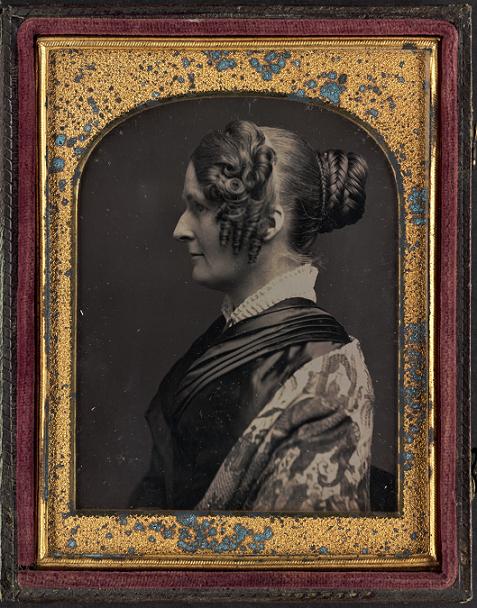
Maria Weston Chapman, active in the Boston Female Anti-Slavery
Society, constant colleague and confidant to Garrison
(photo of a portrait, courtesy, Rare Books, Boston Public Library)
Lydia Maria Child
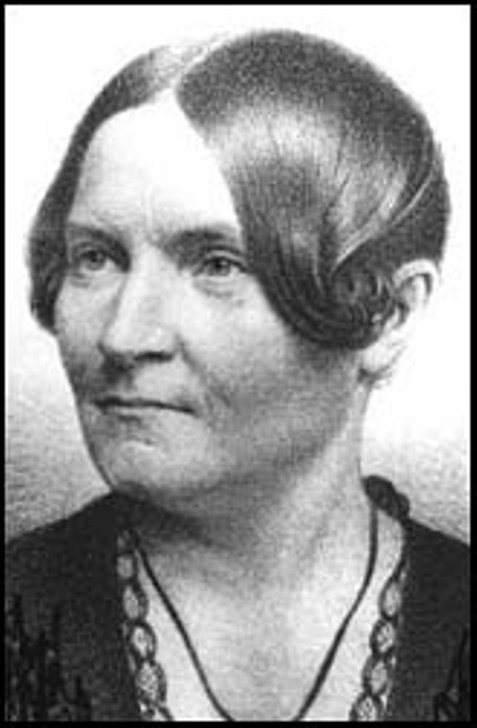
Lydia Maria Child, novelist, author of ” An Appeal of Behalf of that Class of Citizens Called Africans”, in 1833. When she became an Abolitionist, her membership in Boston’s prestigious Library, the Athenaeum, was cancelled. Greatly influenced by Garrison; in the September, 1833 Abolitionist, Garrison presented her work with admiration. She married David Child, a lawyer, one of the first sponsors of the New England Anti-Slavery Society, 1831. The “Appeal” includes a “conversation” between a Colonizationist and an Abolitionist, indicating a clear Garrisonian view.
(photo of a portrait, courtesy, Rare Books, Boston Public Library)
Anti-Texas Annexation Petition Summaries from Massachusetts Towns
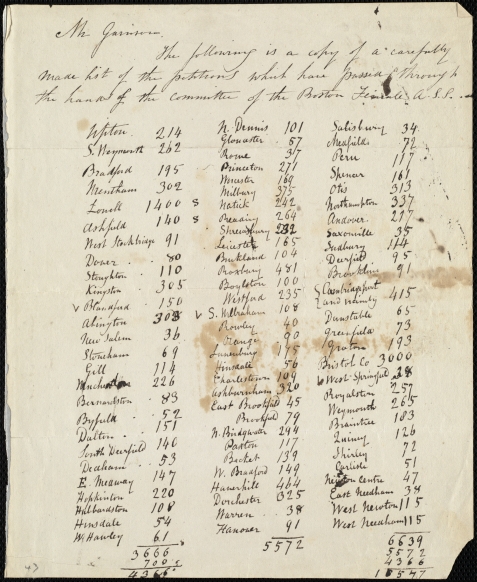
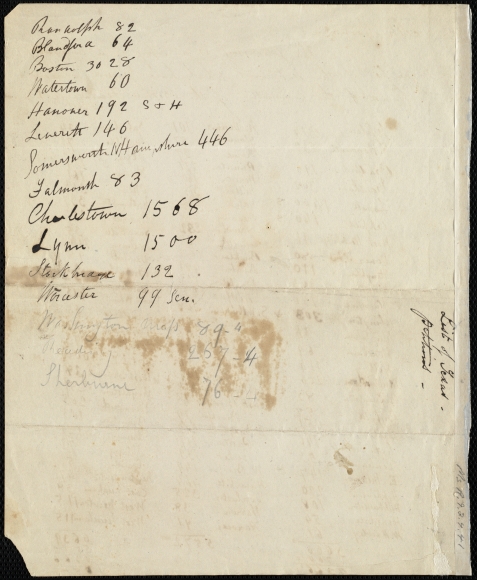
These two pages show the names of local towns in Massachusetts, from which members of the Boston Female Anti-Slavery Society, secured the number of personal signatures shown by each town, on petitions urging against the annexation of Texas as a slave state. The number of signatures exceeds 15,000, illustrative of the hard political work and the statewide influence of the Garrisonian Abolitionists.
(Photo Courtesy of the Trustees of the Boston Public Library/Rare Books)
Francis Jackson
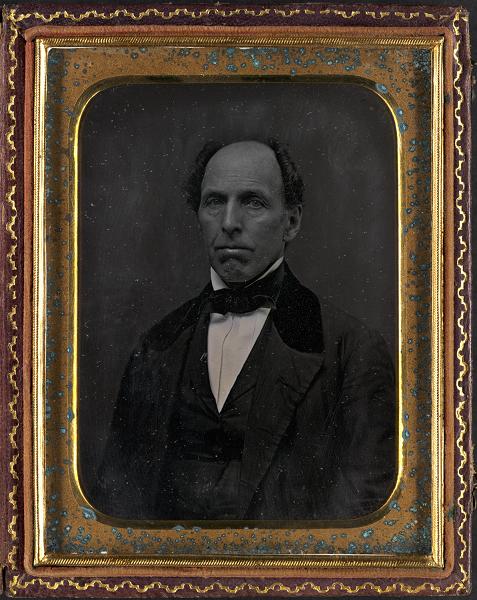
Francis Jackson, Boston’s prosperous broker, friend, benefactor to the Garrison family, for whom Garrison’s last son was named.
(photo of a portrait, courtesy, Rare Books, Boston Public Library)
Liberator composing stone
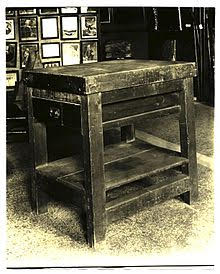
— at the first office site of the Liberator,on Congress Street, close to the Post Office Square
Charles Lenox Remond
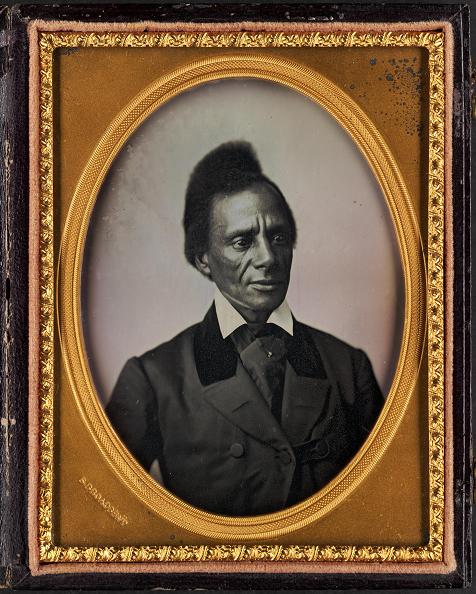
Abolionist leader, recognized for his consistent work in the United States and in England.
(photo of a portrait, courtesy, Rare Books, Boston Public Library)
Anti Abolitionist Cartoon (Click image for larger view)
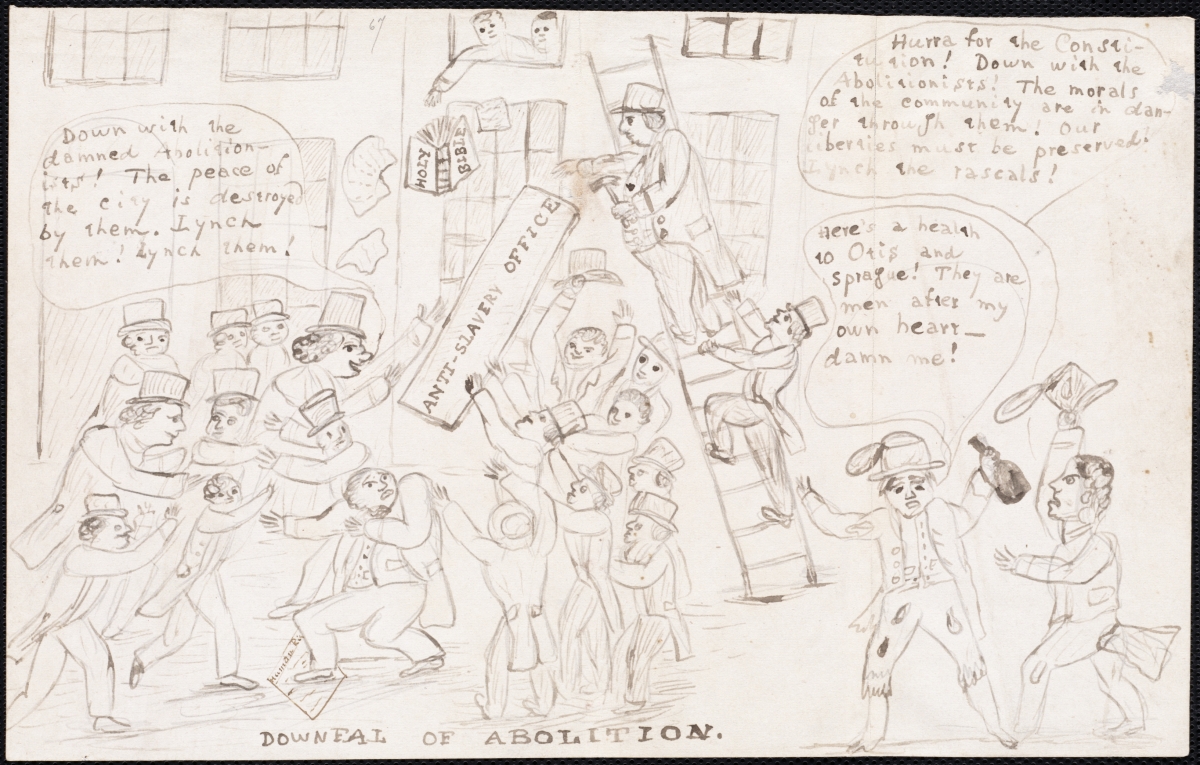
An anti-abolitionist cartoon, showing common intense feelings urging violence against abolitionists.
(Photo Courtesy of the Trustees of the Boston Public Library/Rare Books)
Henry Wilson
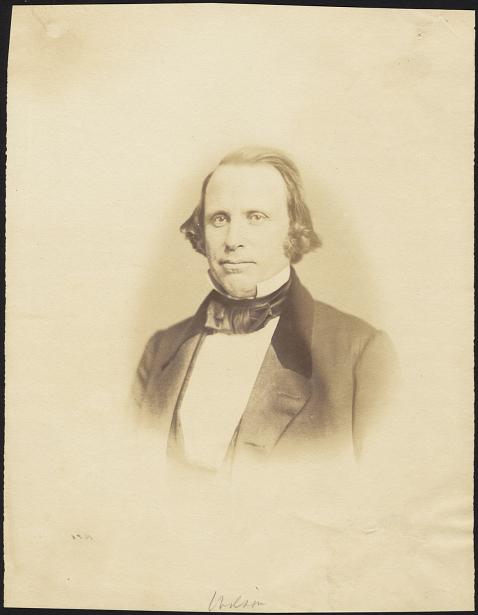
Henry Wilson, United States Senator, from Massachusetts, with whom Garrison frequently corresponded.
(photo of a portrait, courtesy, Rare Books, Boston Public Library)
John Greenleaf Whittier
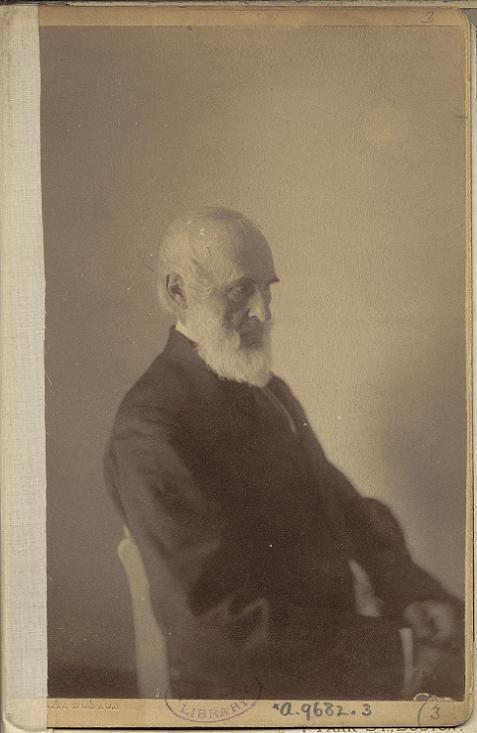
Revered poet of the Abolition movement, early friend of Garrison.
(photo of a portrait, courtesy, Rare Books, Boston Public Library)
A Young Frederick Douglass
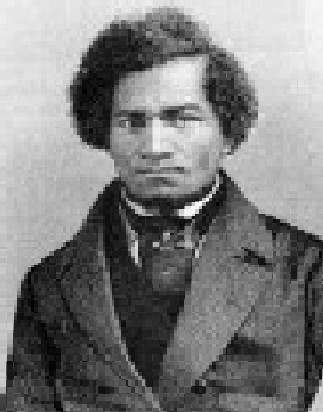
Douglass, early in the days of his self-emancipation was inspired by Garrison and the Liberator. Over the years the two men experienced both personal and ideological division. Douglass eulogized Garrison during a Washington, D.C., memorial service, June 2, 1879, led by Robert Purvis. Douglass characterized Garrison: “He moved not with the tide, but against it. He rose not by the power of The Church or the State, but in bold, inflexible and defiant opposition to the mighty power of both. It was the glory of the man that he could stand alone with the truth, and calmly await the result.”
Phillips, Garrison, Thompson
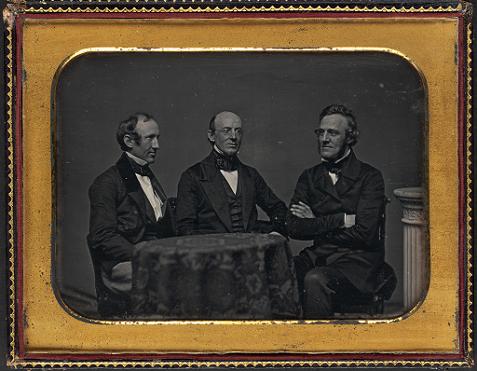
On the left is Wendell Phillips, son of the City of Boston’s first mayor, eloquent Abolition speaker; Garrison in the middle; on the right, George Thompson, English Abolition leader, close collaborator with Garrison. The Garrisons named two of their sons after Phillips and Thompson.
(photo of a portrait, courtesy, Rare Books, Boston Public Library)
Lock To Garrison’s Prison
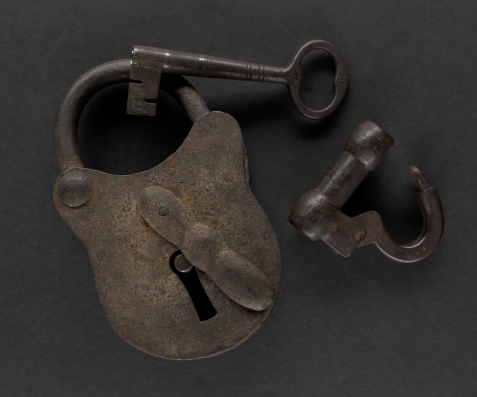
The lock which was used to secure Garrison in a prison, for his protection from men who wanted to lynch him, during the October, 1835 mob action. (For background read “A Moment in Aboliton History”)
(Photo Courtesy of the Trustees of the Boston Public Library/Rare Books)
Daniel Webster
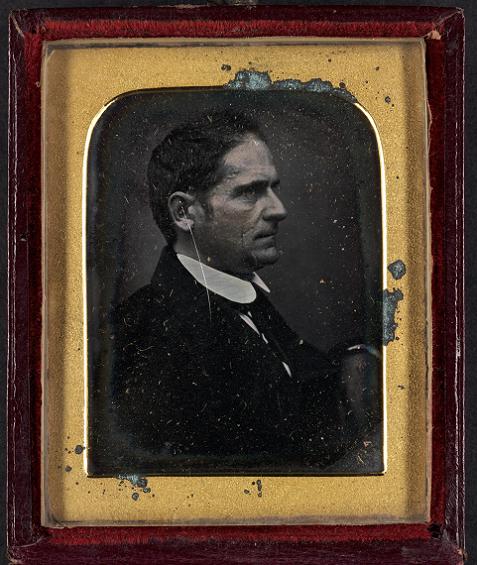
United States Senator from Massachusetts, Secretary of State, noted as eloquent speaker. Because of his part in passing the Compromise of 1850, with an expanded Fugitive Slave Law, Garrison shadowed him with anathema. When the city of Boston erected a statue of Webster, Garrison suggested that it should “be put on its side in the frog pond”. (The statue still stands in front of the State House.!)
(photo of a portrait, courtesy, Rare Books, Boston Public Library)
Westminster Abbey, London
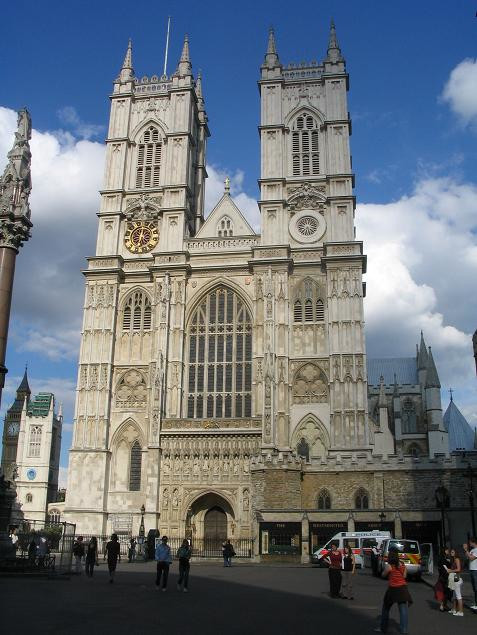
August 5, 1833, Garrison and George Thompson joined in the funeral procession to the Abbey, in tribute to William Wilberforce, renowned English Abolitionist. Prior to his death the two men had visited Wilberforce, in Bath, where he was very ill.
photo by Horace Seldon, July 2007
Henry Clarke Wright
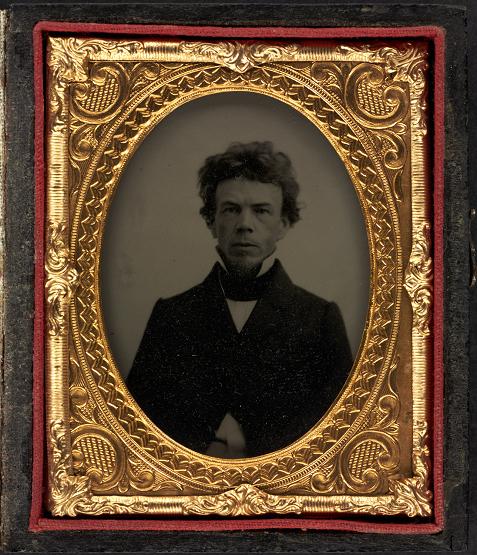
Radical Minister, tutored Garrison in nonresistance, wrote frequently to Liberator, sometimes served as editor when Garrison was absent.
(photo of a portrait, courtesy, Rare Books, Boston Public Library)
Freemasons Hall, London (interior)
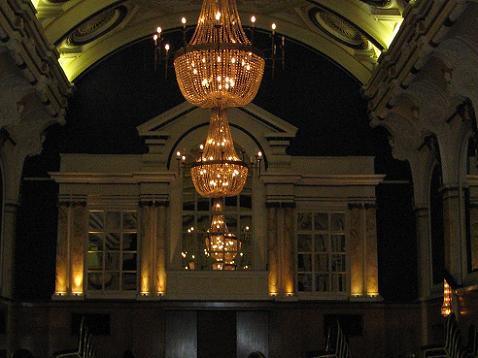
A 2007 partial view of the interior of the Hall, where international delegates met in reponse to an 1840 Convention called by the British and Foreign Anti-Slavery Society.
photo by Horace Seldon, July 2007
Small Gallery (loft) of the Freemasons Hall
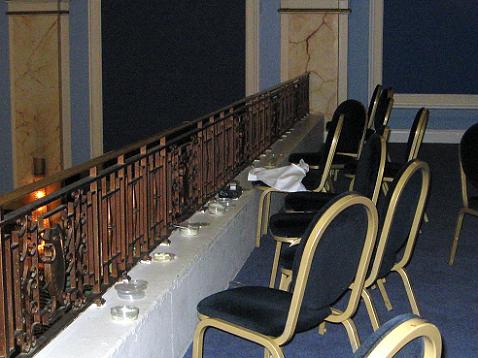
Loft of the Freemasons Hall overlooking the main floor, on which delegates convened. Garrison arrived on June 18, 1840, with an American delegation which included women. By act of the Convention, women delegates were excluded from participation in debate and voting. In protest Garrison, and three other American male delegates, took seats in this Gallery, and “sat-out” the Convention, refusing to take part. The three who sat with Garrison were Charles Lenox Remond,
Nathanel P. Rogers, and William Adams. As leader of the American delegation, Garrison, by this act dominated the Convention without speaking a word.
photo by Horace Seldon, July 2007
Statue of Garrison in Newburyport, Mass.
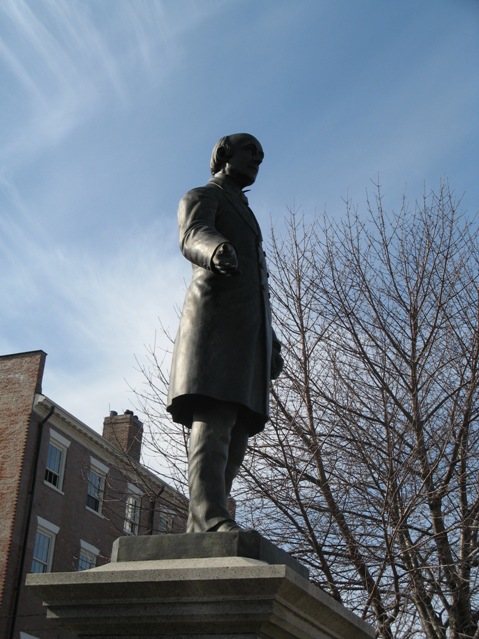
Statue of William Lloyd Garrison by Daniel Murray French, in Garrison’s birthplace, Newburyport, MA.
Statue of Garrison in Boston
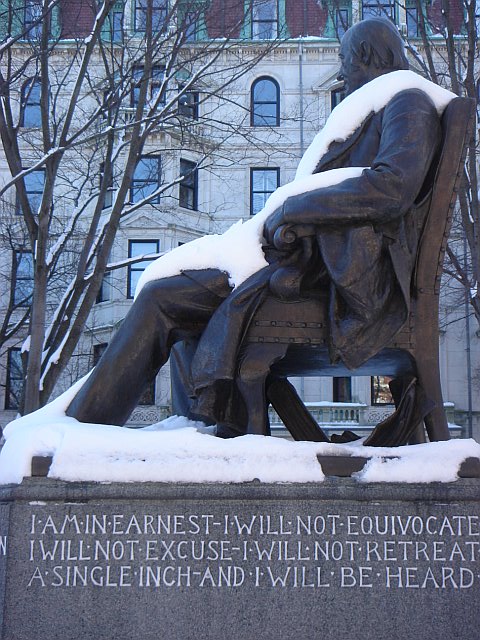
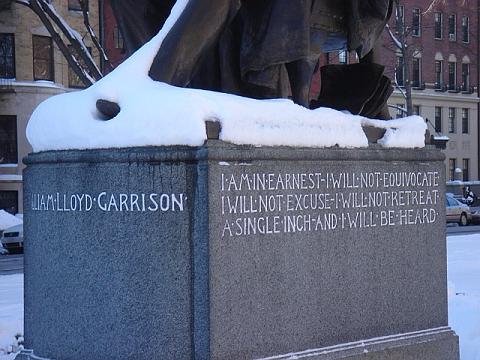
Local Boston photographer, Bob Lake, had some fun in the snow at a statue of Garrison, on Commonwealth Ave. boulevard. Playing on the fact that Garrison faced slavery, saying that he ‘must be all on fire’, because there ‘were mountains of ice to melt’, the photos show him in snow! At the base of the statue other famous Garrison quotes are seen.
photos by Bob Lake, March 2008
William Cooper Nell
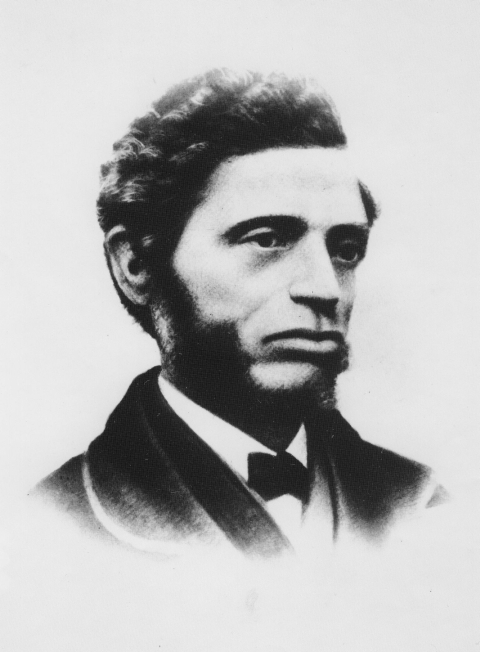
First published black Historian, and leader in the Equal School Rights Movement, of Boston’s 19th century black community
Abby Kelley
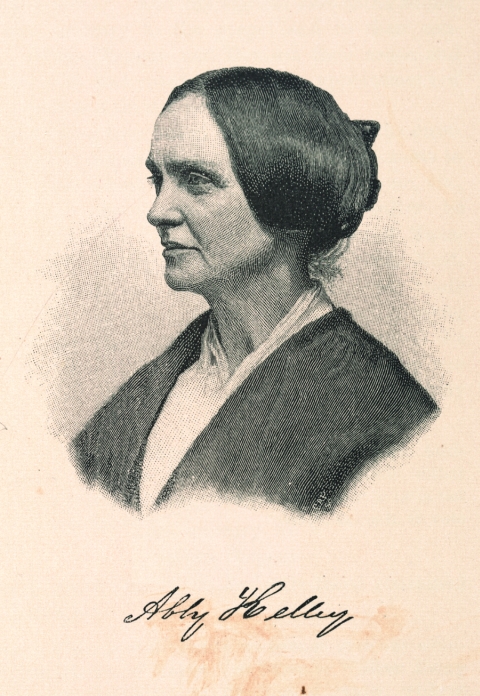
Abolitionist, leader of womens rights movement. Her election to the business meeting of the American Anti-Slavery Society, 1840, was the occasion of strong objection by opponents of the ” woman question”.
Helen Frances Garrison
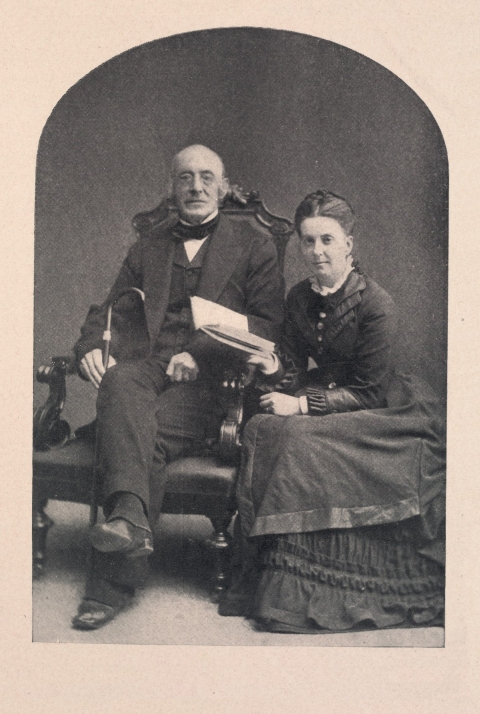
Garrison with daughter, Helen Frances Garrison, (1844-1928) Affectionately called Fanny. One of two daughters, the other died as child.
Lewis Hayden
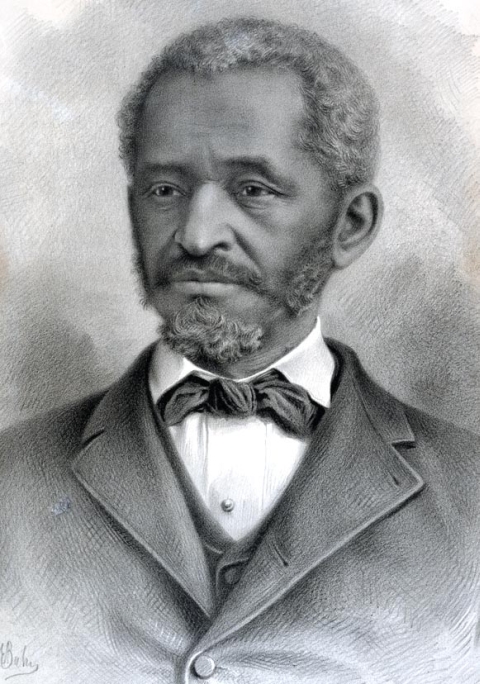
Former slave, he and his wife sheltered many blacks who were in flight from Fugitive Slave Catchers. Key leader in the Boston movement to defy and resist the Fugitive Slave Law, 1850.
Contribution Box
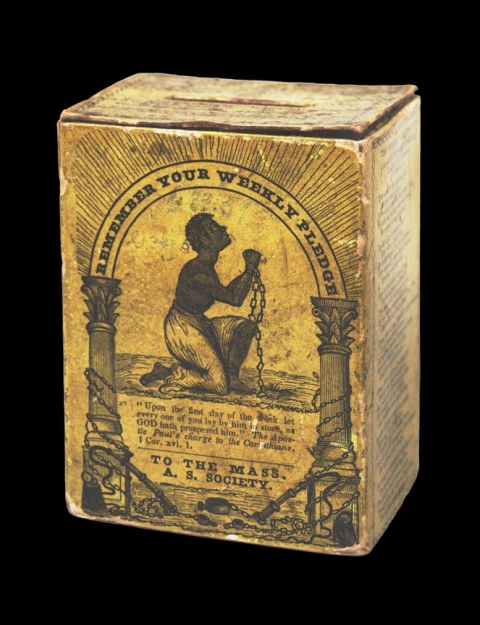
A contribution box, used to gather pennies, other coins, in support of the Massachusetts Anti-Slavery Society.
Garrison Birthplace
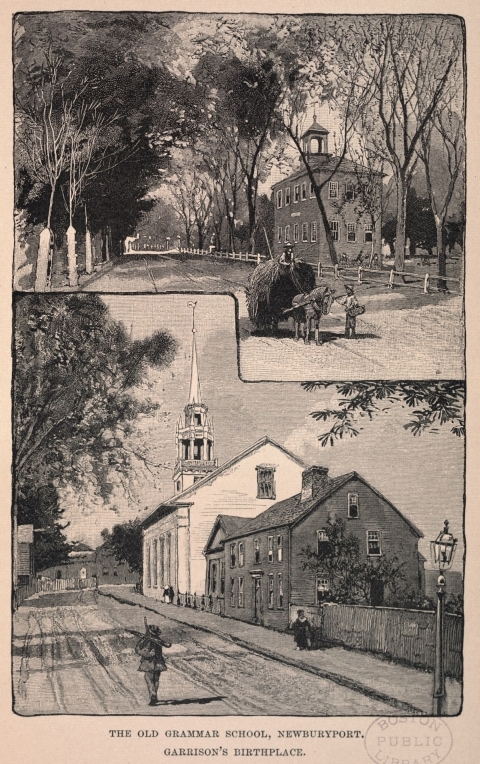
Newburyport, Mass.
Mob at Tremont Temple
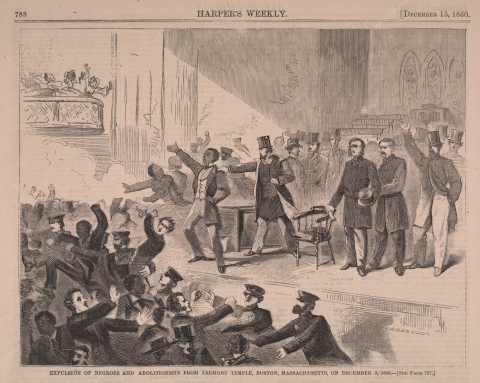
Picture depicting a mob action to expel Negro speakers from Tremont Temple, Boston, in December, 1860
William Lloyd Garrison at age of 20
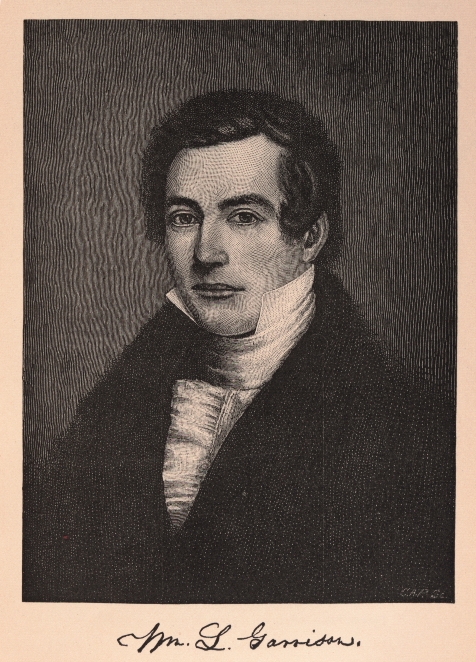
An oil painting by William Swain, found to “have no resemblance in it” by Garrison’s schoolmate, Mr. Thomas B. Lawson
Benjamin Lundy
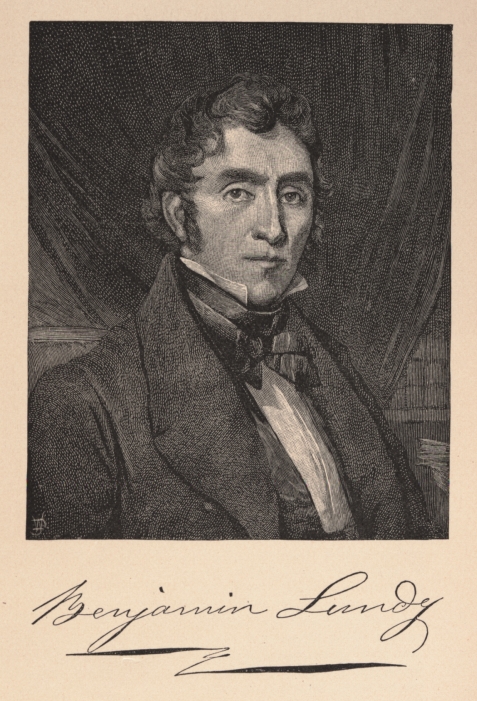
Lundy was editor of the Genius of Universal Emancipation, in Baltimore, with whom Garrison associated prior to establishing the Liberator. Lundy also later edited The National Enquirer, in Pennsylvania.
Shields of Slavery (Click image for larger view)
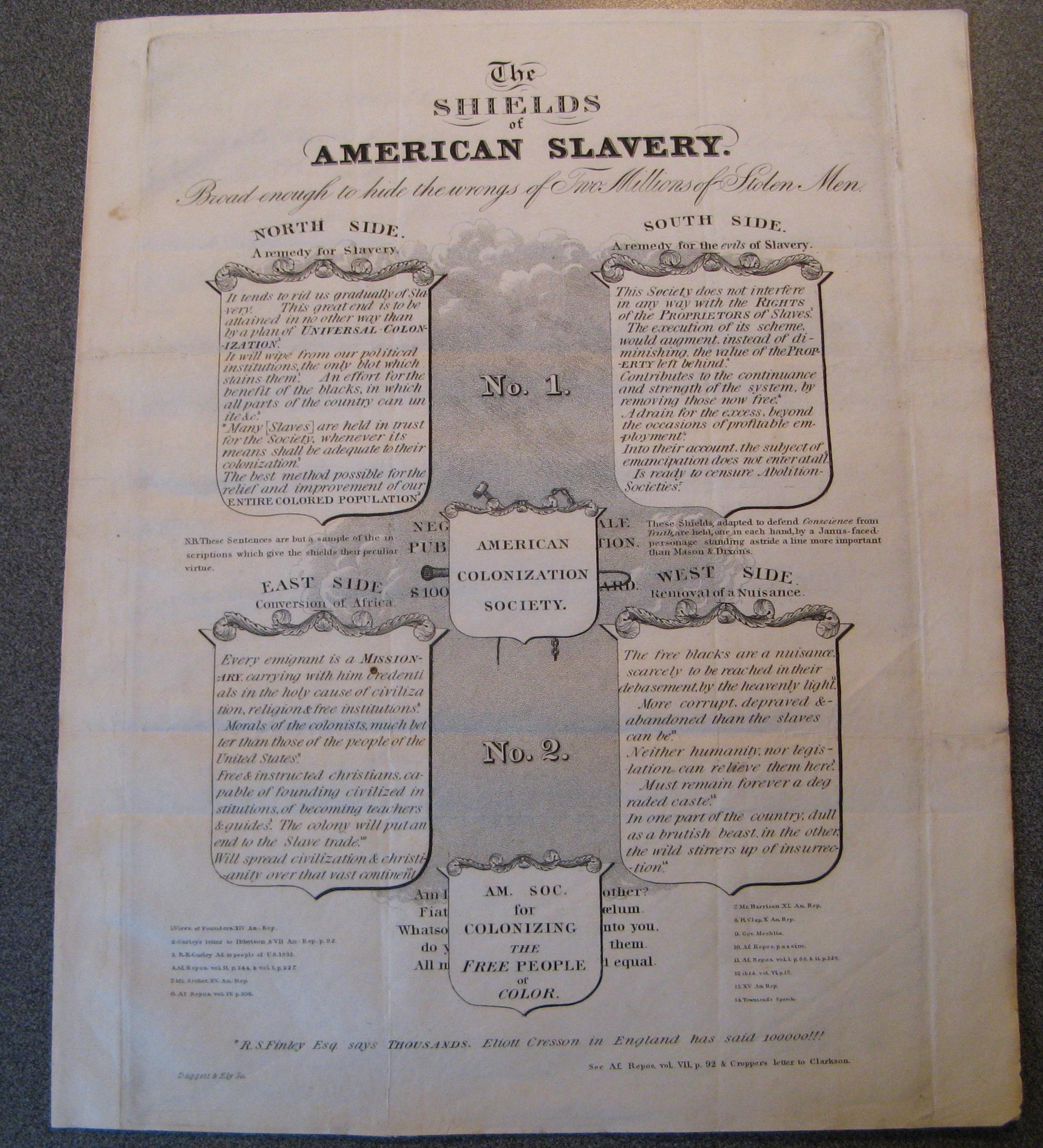
Here is a strong graphic statement in harsh condemnation of the American Colonization Society. It pretends to depict four “shields” raised in defense of the ACS. It is presented as a clear rebuke to each of four arguments on the four “shields”. The arguments represent the ACS position that it is “A remedy for slavery”, “A remedy for the evils of Slavery”, a vehicle for the “Conversion of Africa”, and for the “Removal of a Nuisance”. At the bottom of the graphic, it addresses ACS agents, R.S. Finley, and Eliott Cresson, in mocking terms. It is presented here because the ACS was the subject of a strong 236 page critique by Garrison, Thoughts on African Colonization, of which 2750 copies were published in 1832. (This “shield” probably had early use in a letter from James Cropper, the Liverpool merchant-abolitionist, written to Thomas Clarkson.)
Lundy’s Newspaper Genius of Universal Emancipation (Click image for larger view)
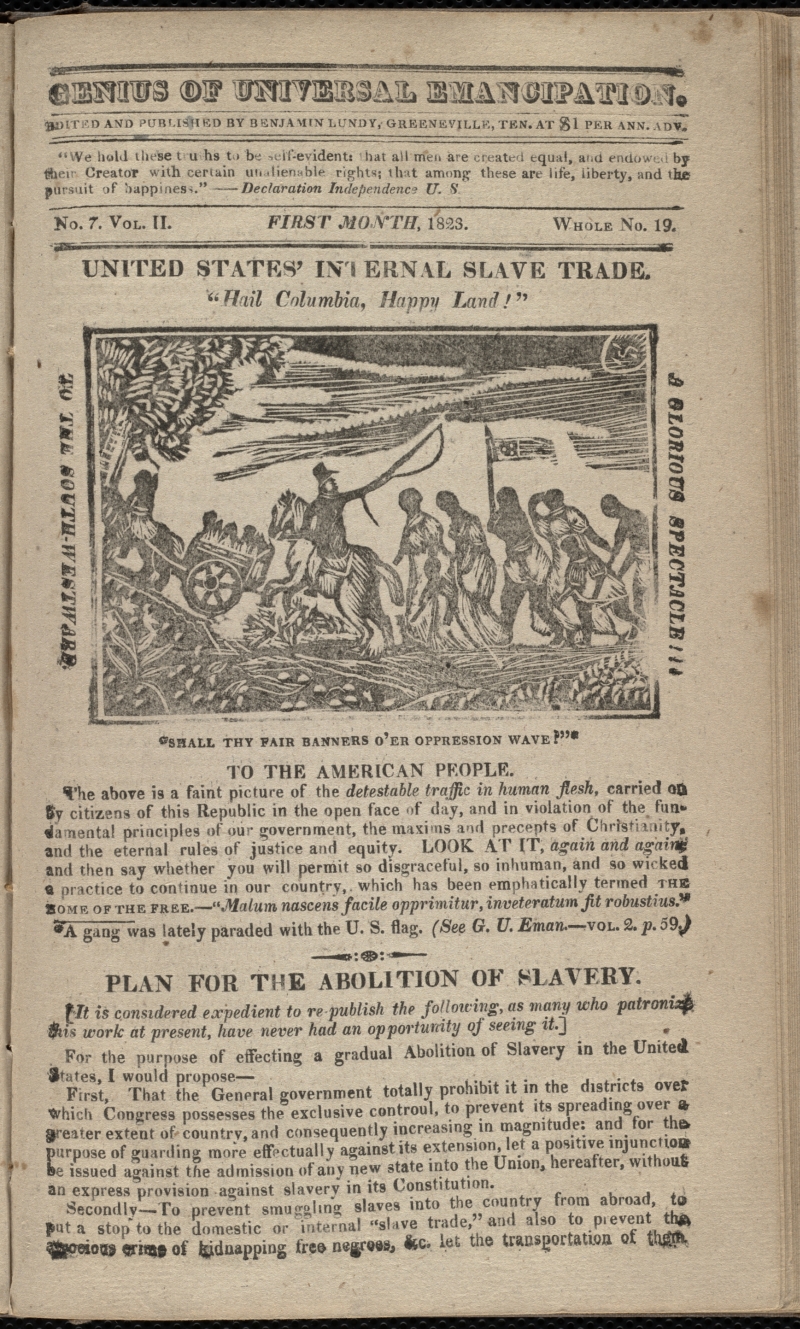
Masthead and the first page of the Genius of Universal Emancipation, the early newspaper created by Lundy. In 1829 Garrison joined Lundy in Baltimore, to aid in editing the paper. After Garrison was convicted and jailed for libel, and in amicable agreement, the union was dissolved. Garrison created the Liberator in 1831. The Genius of Emancipation continued, with Lundy alone.
(Photo Courtesy of the Trustees of the Boston Public Library/Rare Books)
Arthur Tappan
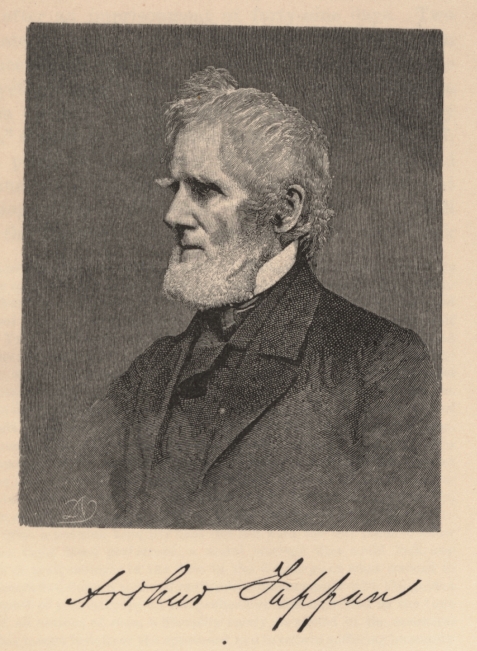
Early supporter of Garrison. As President of the American Anti-Slavery Society, Arthur and his brother, Lewis, broke with Garrison in 1840, but was reconciled later in life.
Page 1 of The Liberator, No. 17, April 23, 1831
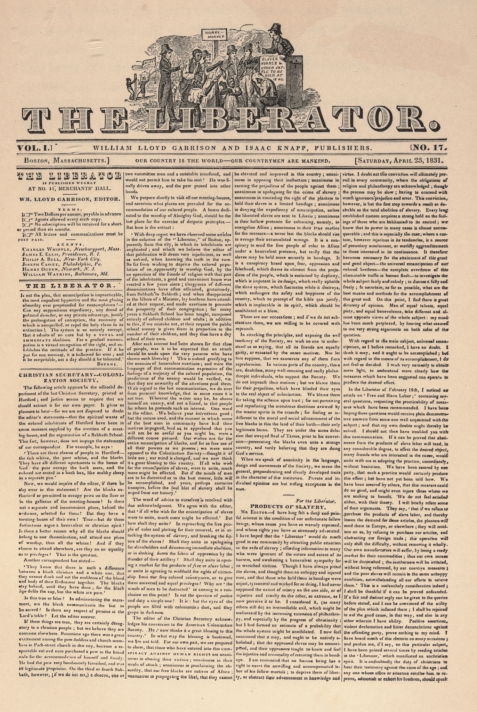
Isaac Knapp, at age 36, about 1840
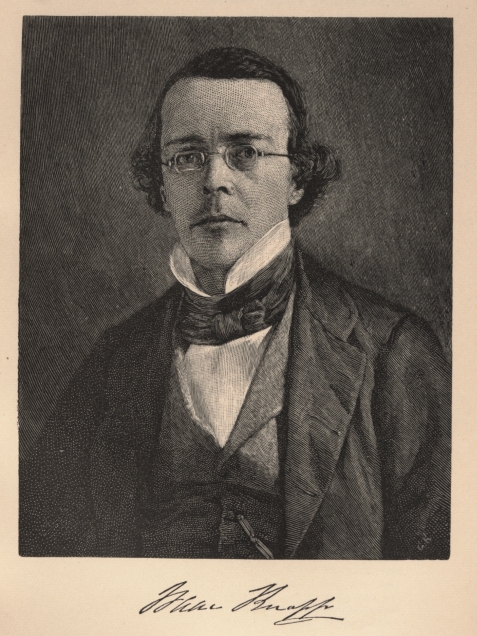
A boyhood friend, Knapp served as co-editor of the Liberator, a position, from which he was dismissed in 1839, because of alcoholism, a condition which led to his death in 1843.
Prudence Crandall, at age of 31
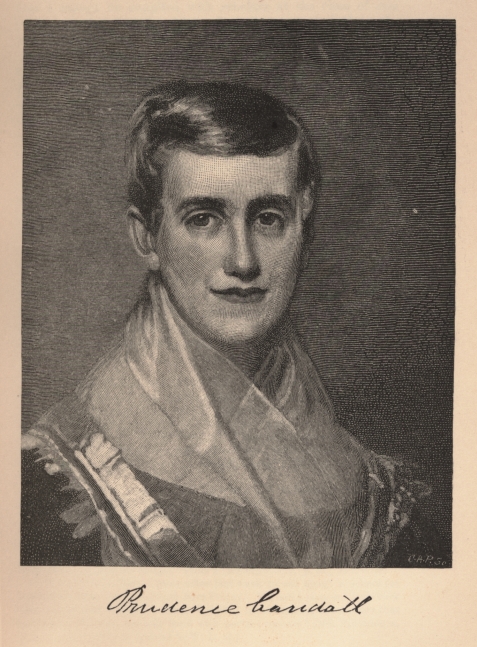
A schoolteacher, in Canterbury, Connecticut, met strong resistance when she enrolled black children in her school. She suffered community intimidation, legal prosecution, and physical violence. Garrison gave strong support to her effort, but she was unable to continue the school.
George Thompson, at age 47, in 1850-1851
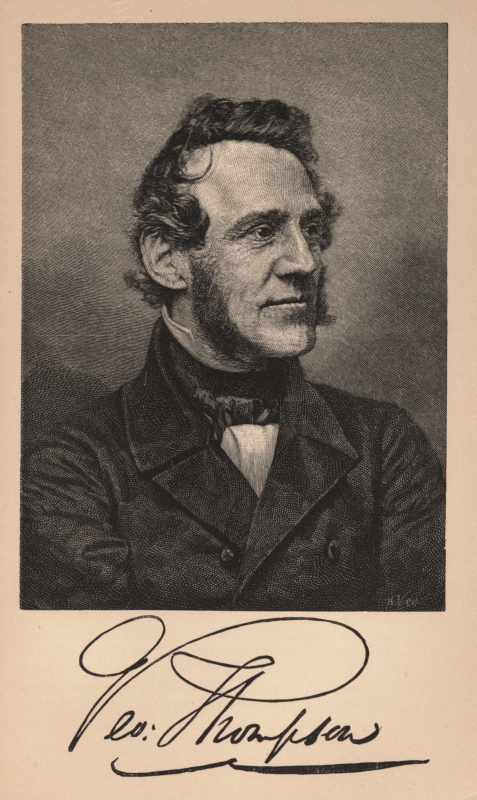
United Kingdom abolitionist, close friend and ally to Garrison, after meeting in London, in 1833. Thompson visited the United States, speaking for long periods in the anti-slavery cause.
Silver Cup presented to Garrison by his “coloured friends” – April, 1833
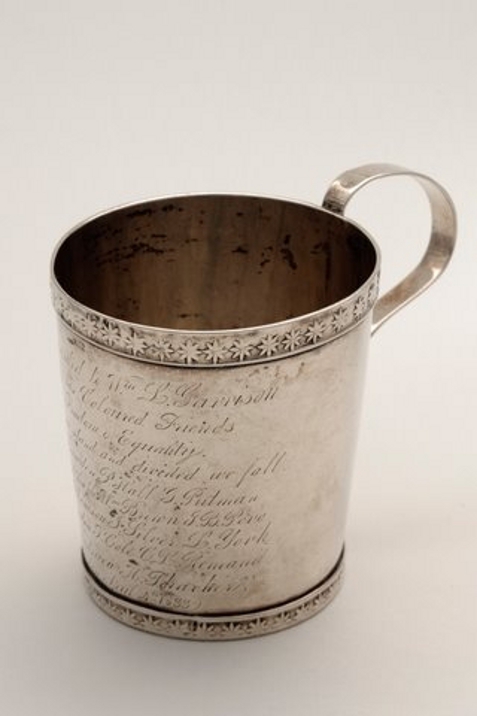
This cup was presented to Garrison as he was preparing to leave Boston for his trip to England, in April, 1833. The presentation occurred at the home of George Putnam, after a community meeting at the African Meeting House. The inscription reads:
by his Coloured Friends
Freedom & Equality
United we stand and divided we fall
David Snowden P. Hall G. Putnam
P. Howard C. Caples Wm. Brown J. B. Pero
J. Hilton G. Thomson J. Silver L. York
J. Lewis F. Standin T. Cole C. L. Remond
E. J. B. Mundueu H. Thacker
Boston, April 4th 1833
(Courtesy of Museum of African American History)
Samuel Joseph May, at age of 50, about 1847
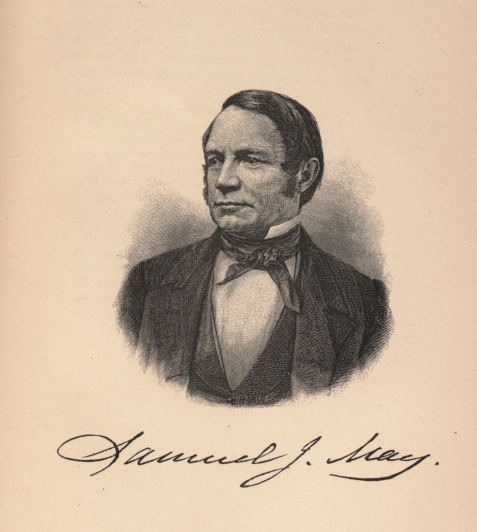
Connecticut pastor, early supporter of Garrison, and senior colleague and confidant.
Sarah Grimké, at age 50
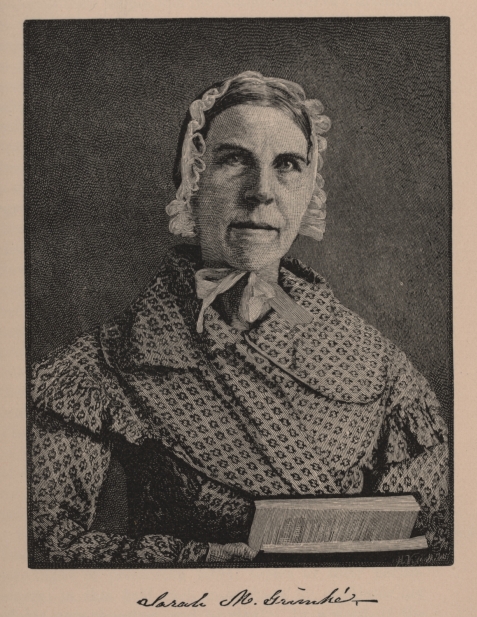
Angelina Grimké, at age 39
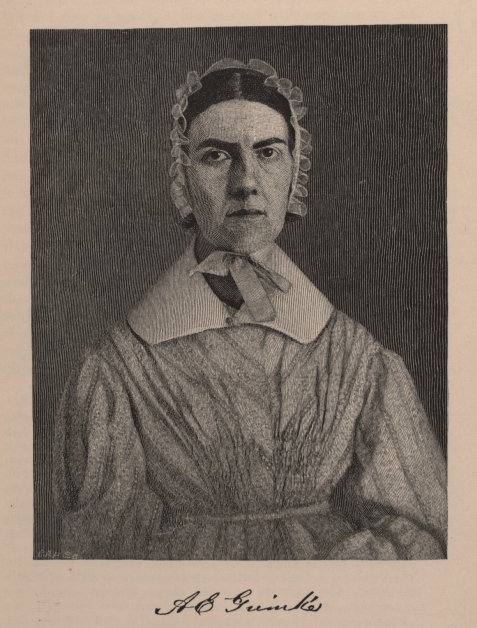
The Grimké sisters, Sarah and Angelina, daughters of a large South Carolina slaveholding father, left the family, became leading abolitionist speakers, and were among the earliest of women to assume such roles in the movement.
Helen Eliza Garrison, at age 42
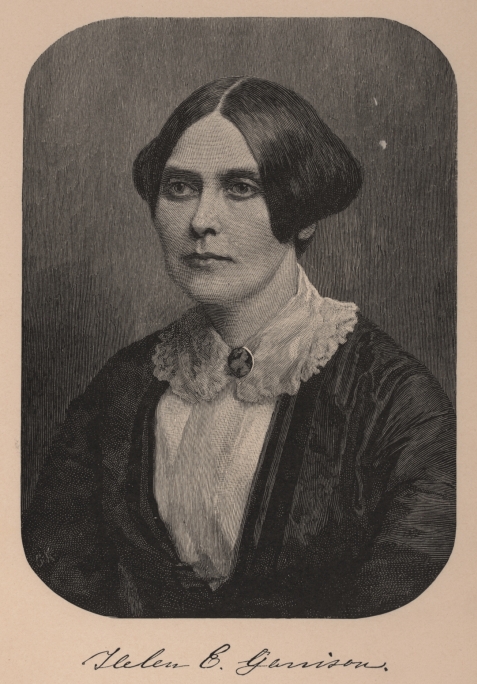
Wife, strongly abolitionist, active in Boston Female Anti-Slavery fairs. A measure of her devotion can be felt in the many letters between Garrison and herself.
Nathaniel Peabody Rogers
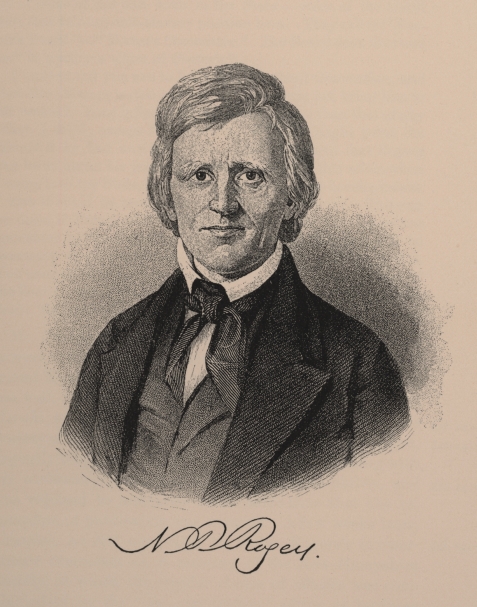
New Hampshire friend, on of the men who “sat-out” the 1840 London Convention with Garrison.
Four different Liberator Mastheads
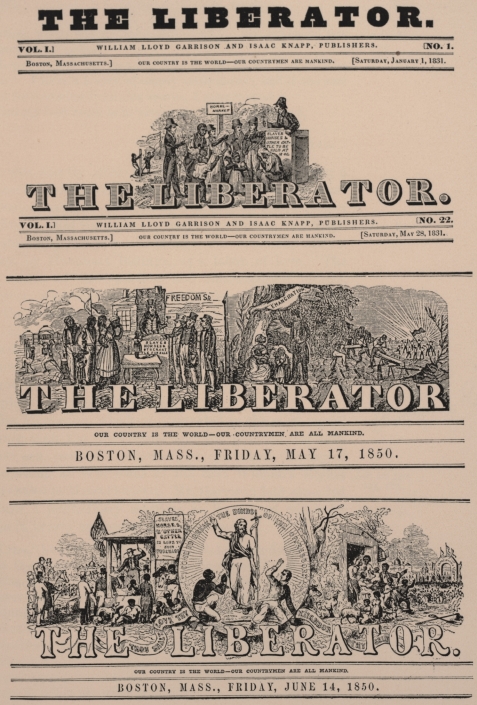
Elizabeth Pease at age 44
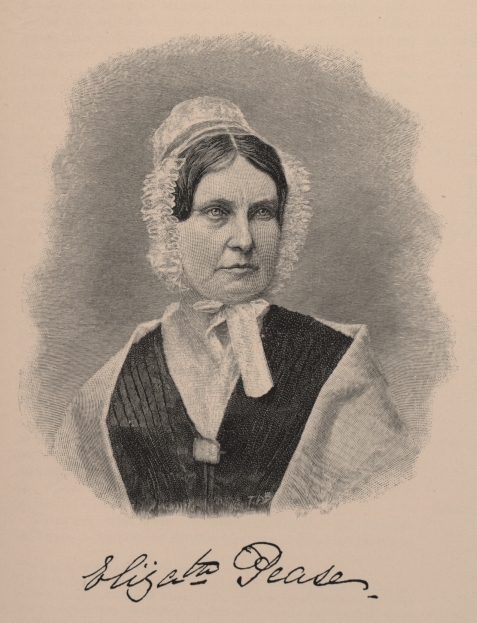
English Quaker, leader in movements for Abolition, Peace, and Woman Suffrage, greatly influenced Garrison, and for whom one of the Garrison children was named.
Edmund Quincy at age 60
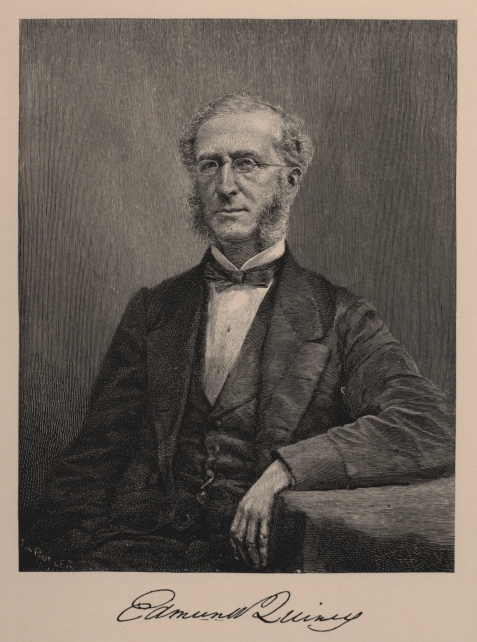
Son of a Boston Mayor, converted to active Abolitionist at the time of the 1835 Boston mob action against Garrison. Frequently edited the Liberator, friend and consultant to Garrison.
William Lloyd Garrison at age 69
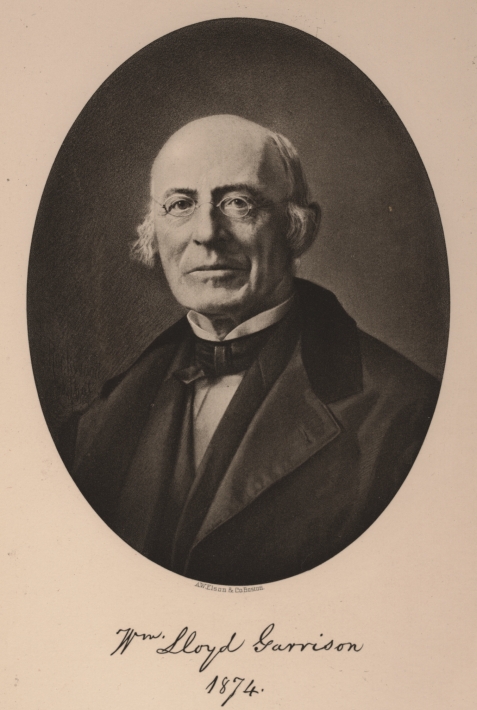
William and Ellen Craft
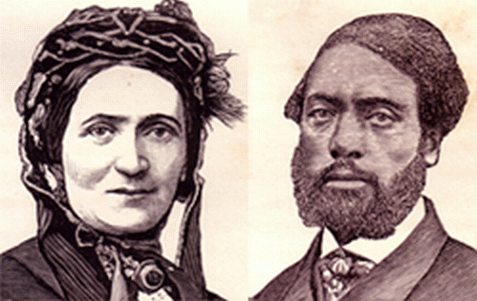
Fugitive slave couple, 1851, whose remarkable escape from slavery still astounds history;
spent the Civil War period in England, teaching, and supporting the United Kingdom anti-slavery efforts.
The Crandall Museum, the home of Prudence Crandall
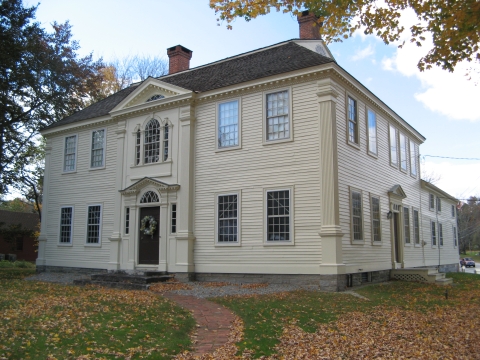
Prudence Crandall’s home, in Canterbury, Connecticut, where she opened her school to black girls in 1834, forced to close after verbal and physical attacks, and legal prosecution. Garrison was strong in support of her dedication to equal education. (Photo courtesy of Museum Curator, K. Kozlowski)
Interior of the Unitarian Church, Brooklyn, Connecticut.
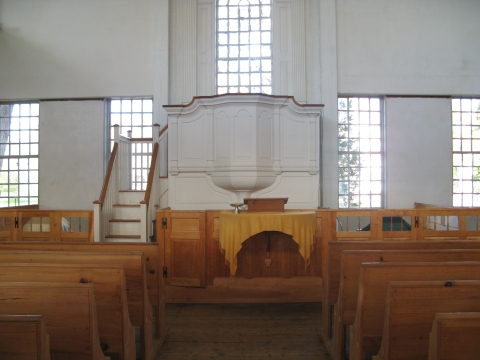
Samuel J. May, early devotee and long-time confidant for Garrison, was minister here
Courthouse, Brooklyn, Connecticut
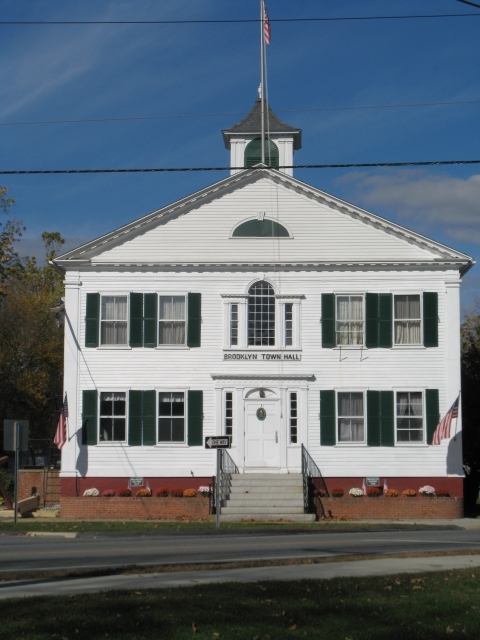
This is where Prudence Crandall was tried three times for violating a law because she opened her school to black girls.
Friendship’s Vale
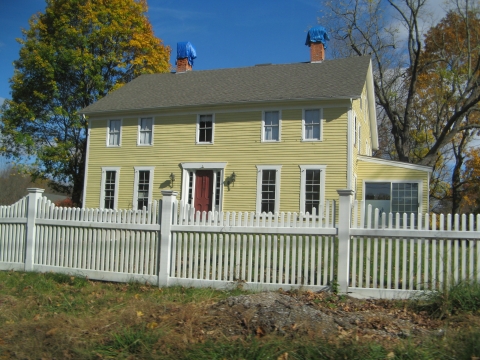
The home of Helen Benson, who married Garrison, in 1834. The wedding took place in the parlor of this house, performed by Samuel J. May
Friendship’s Vale
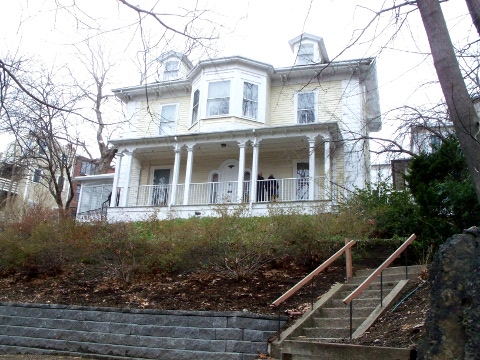
The last home of William Lloyd Garrison, Roxbury, Massachusetts, 1864
Noyes Academy, Canaan, New Hampshire
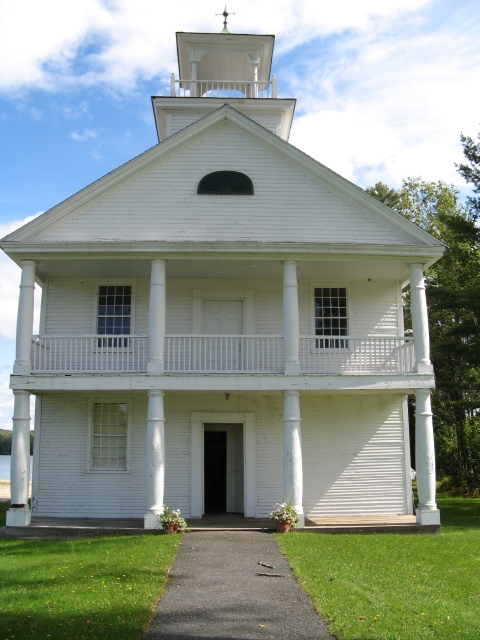
This Academy was opened in 1835 for “youth of good character,
without distinction of color”. Black students included Alexander Crummell, Henry Highland Garnet, and Julia Williams, all of whom became historic black leaders. Open only months, the building was literally dragged away, the building later torched, and this early attempt at integrated education failed. Active among the Trustees were David Child, S.E. Sewall, of Boston, and Nathanel P. Rogers, of New Hampshire, all friends of Mr. Garrison. This photo is of a rebuilt replica of the destroyed Academy.
Removal of Noyes Academy (Click image for larger view)
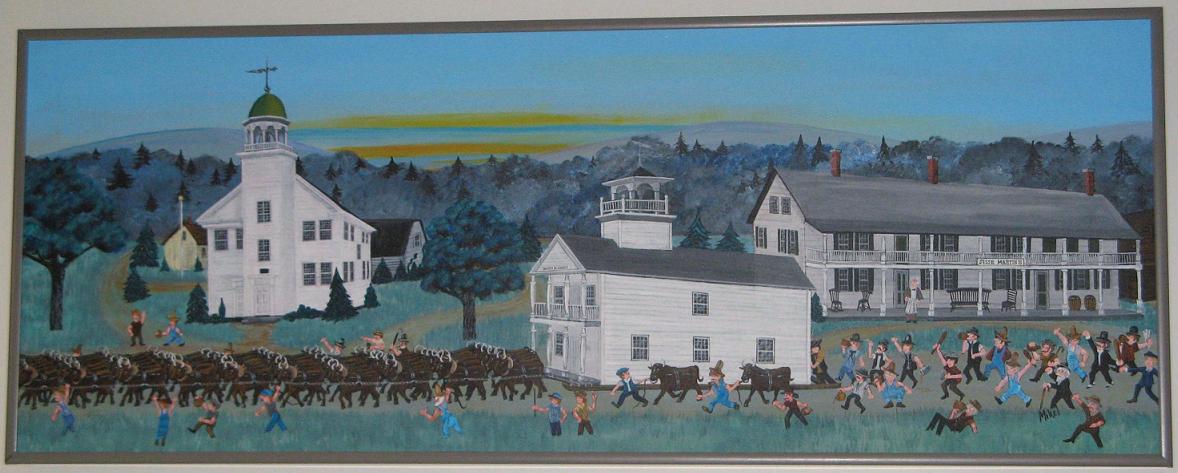
This painting, by Mikel Wells, depicts the 1835 Removal of Noyes Academy. Presented here by coutesy of the Canaan Historical Society.
The Gravestone for both Helen Eliza Garrison (Benson) and William Lloyd Garrison
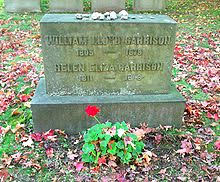
Helen Eliza Garrison (Benson) 1811-1876
William Lloyd Garrison– 1805-1879
Four angle-shots of the Death Mask of William Lloyd Garrison. (Click image for larger view)

(Photo Courtesy of the Trustees of the Boston Public Library/Rare Books)
(Click image for larger view)
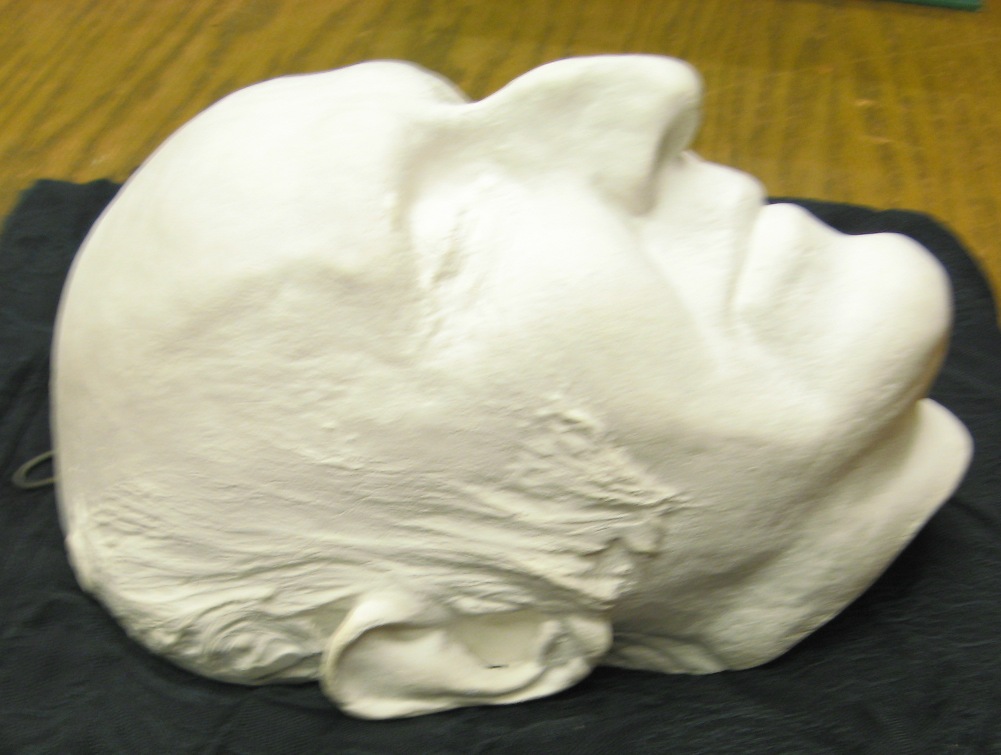
(Photo Courtesy of the Trustees of the Boston Public Library/Rare Books)
(Click image for larger view)
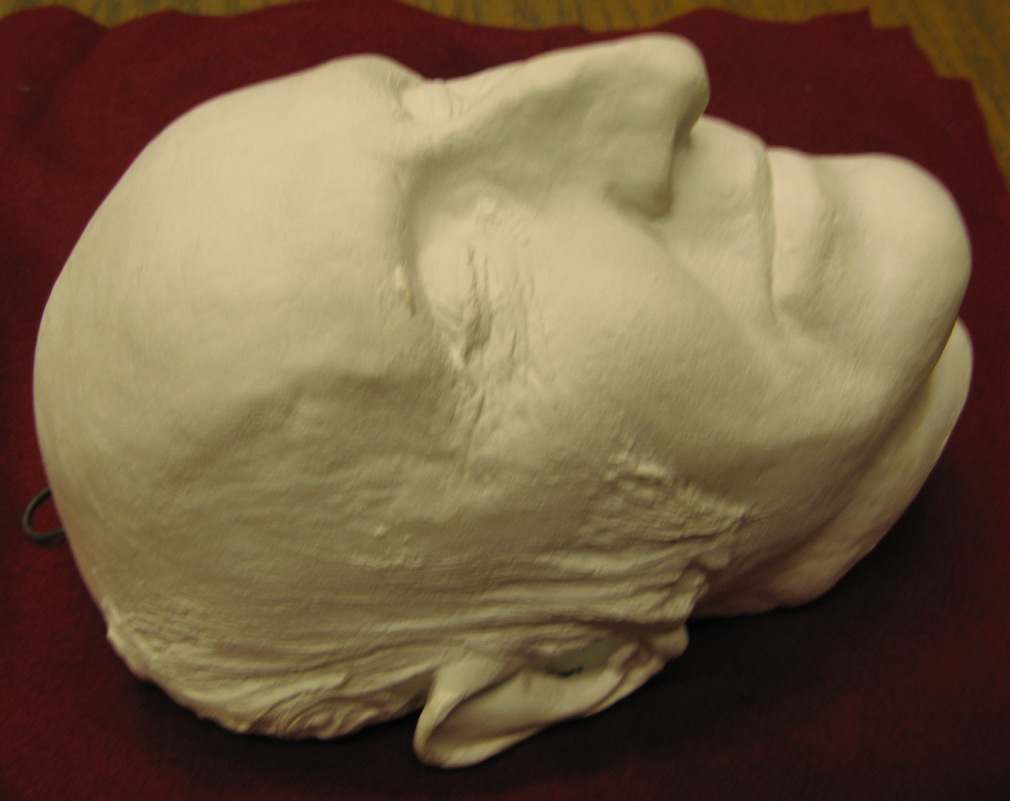
(Photo Courtesy of the Trustees of the Boston Public Library/Rare Books)
(Click image for larger view)
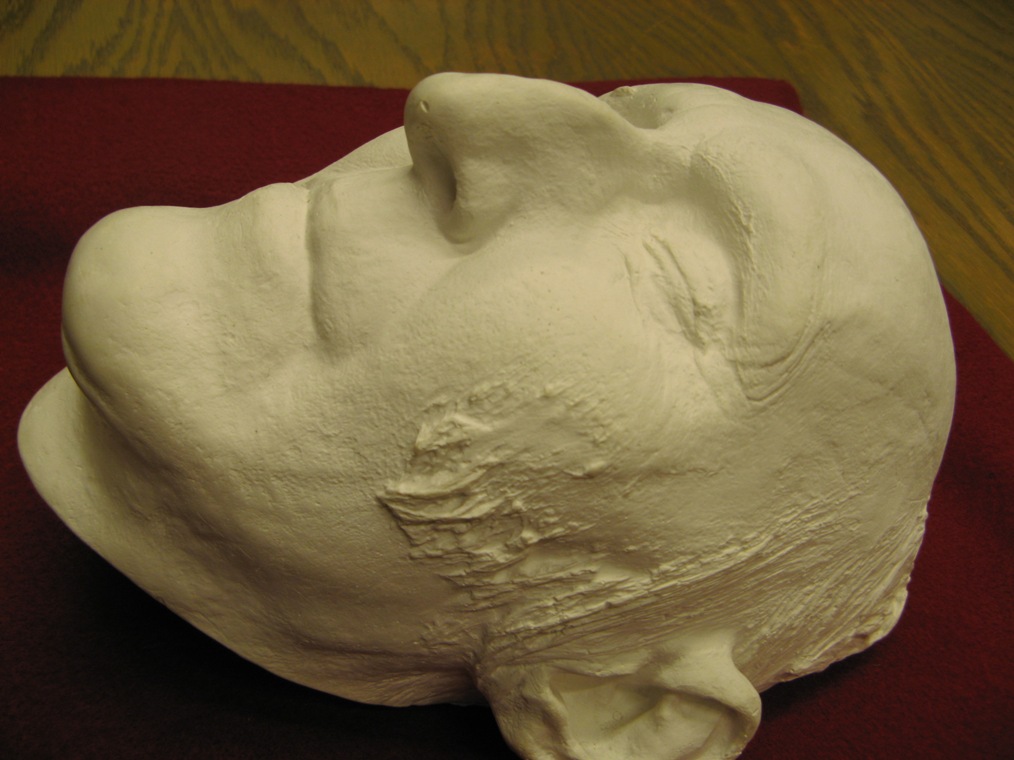
(Photo Courtesy of the Trustees of the Boston Public Library/Rare Books)
there is mistake!
the photo of Daniel Webster replaced with that of Henry Clarke Wright.
Hello my name is Ricky Scarbrough, member of the historic Monumental Baptism Church in Philadelphia, under the leadership of the Rev Dr Wendell Mapson, our church is coming up on our 200 year anniversary, we are in search for a picture of our 1st pastor Rev Greoge H Black, we are hoping that you might be able to help us find one . Thank you